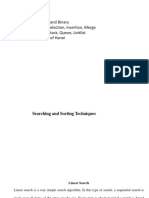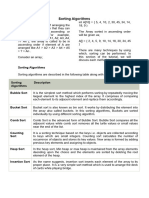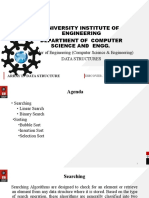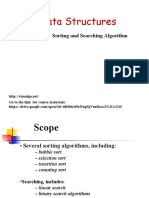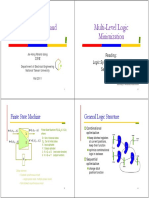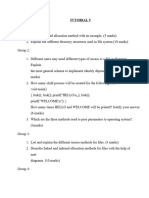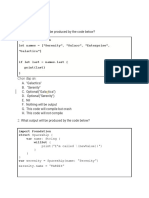Assignment Data Structures and Algorithms
Student Number: HE12628
Student Name: Mazilu Ioana-Adriana
0
� Table of Contents
Introduction............................................................................................................................... 3
Task 1 .................................................................................................................................... 3
Description........................................................................................................................ 3
Linear Search................................................................................................................... 4
Bubble Sort....................................................................................................................... 6
Graphical Visualisation ................................................................................................... 8
Insertion Sort .................................................................................................................. 11
Graphical Visualisation ................................................................................................. 14
Big O Notations.............................................................................................................. 16
Complete Code .............................................................................................................. 18
Test Logs ........................................................................................................................ 19
Output.............................................................................................................................. 20
Task 2_1.............................................................................................................................. 20
Description...................................................................................................................... 20
Complete Code .............................................................................................................. 20
Shallow Copy ................................................................................................................. 25
Advantages of ArrayList ............................................................................................... 26
Disadvantages of ArrayList .......................................................................................... 26
Test Logs ........................................................................................................................ 26
Output.............................................................................................................................. 30
Task 2_2.............................................................................................................................. 30
1
� Description...................................................................................................................... 30
Complete Code .............................................................................................................. 31
Advantages of ArrayDeque that implements Deque interface ............................... 36
Disadvantages of ArrayDeque that implements Deque interface .......................... 37
Test Logs ........................................................................................................................ 37
Output.............................................................................................................................. 40
Task 2_3.............................................................................................................................. 40
Description...................................................................................................................... 40
Complete Code .............................................................................................................. 41
Advantages of PriorityQueue ...................................................................................... 45
Disadvantages of PriorityQueue ................................................................................. 45
Test Logs ........................................................................................................................ 45
Output.............................................................................................................................. 48
Task 3 .................................................................................................................................. 48
References ............................................................................................................................. 49
Appendix ................................................................................................................................. 50
2
� Introduction
This Java programming project will cover a wide range of computer science
subjects, such as data structures, sorting techniques, searching algorithms, and
object-oriented programming concepts. The exercises aim to strengthen
understanding of the Java collections framework, algorithmic efficiency, and the
practical implications of data structure selection on the behaviour and performance of
programmes. In the first task, various data structures, including bubble sort, insertion
sort, and linear search, are implemented in a given array. There are three smaller jobs
in the second task. ArrayList and Shallow copy are implemented in the first subtask;
ArrayDeque is implemented in the second subtask in place of ArrayList; and
PriorityQueue is implemented in the third subtask in place of ArrayList. In Task 3, a
reflection of this assignment is requested to underline the understanding of the
requirements, steps taken, challenges and ability to find solutions.
Task 1
Description
The first task involves a thorough analysis of the Java implementation of the
linear search algorithm and how it works to locate a particular member in an unsorted
array. The design, implementation, and discussion of the linear search will be followed
by an examination of the subtle differences between Bubble Sort and Insertion Sort.
Flowcharts, graphical visualisations, and pseudocode will be used to augment the
explanations. Code samples, testing proof, and a comparative study of the Big O
notations for the algorithms will all be presented.
3
�Linear Search
Explanation
The linear search is started by comparing the first item of given array with the
searched item by user (Horstmann 2020). If matched, then the search is ended and
returns the index of the item; if not, -1 is returned to indicate that the target is not in
the list and move on to the next item.
Pseudocode
4
�Flowchart
Code Snippet
5
�Bubble Sort
Explanation
The stated sorting algorithm is done by swapping adjacent elements repeatedly
if these elements are present in the wrong order till no further swaps are required
(Insanudin 2019).
Pseudocode
6
�Flowchart
7
�Graphical Visualisation
Let assume the given array is {5,2,30,41,22}.
i)
ii)
iii)
8
�iv)
v)
vi)
vii)
9
�viii)
ix)
x)
xi)
10
�xii)
This is the final output after bubble sorting.
Code Snippet
Insertion Sort
Explanation
The stated sorting algorithm is done by making a sorted array a single item at
a time (Ali, Nawaz and Maitlo 2021). For each iteration, a single item is taken from the
input data to find its perfect position within the sorted list and moved higher elements
up to make the space.
11
�Pseudocode
12
�Flowchart
13
�Graphical Visualisation
Let assume the given array is {5,2,30,41,22}.
i)
ii)
iii)
14
�iv)
v)
vi)
vii)
15
�viii)
This is the final output after insertion sorting.
Code Snippet
Big O Notations
Time complexity of linear search algorithm: O(n).
Time complexity of bubble sort algorithm: O(n^2).
Time complexity of Insertion sort algorithm: O(n^2).
While Bubble Sort and Insertion Sort have similar worst-case and average time
complexity (O(n^2)), Insertion Sort works better with smaller arrays or arrays that are
16
�almost sorted. Although it isn't related to the sorting, Linear Search has an O(n) time
complexity and is included here as part of the overall assignment.
Big O Notation Graphic
17
�Complete Code
18
�Test Logs
Test Case Input Expected Actual Output Result
Name Output
Linear Search {5, 2, Index 11 Index 11 Passed
30, 41,
22, 15,
25, 6,
33, 20,
13, 44,
39, 27,
5, 11}
44
Bubble Sort {5, 2, [2, 5, 5, 6, 11, [2, 5, 5, 6, 11, Passed
30, 41, 13, 15, 20, 22, 13, 15, 20, 22,
22, 15, 25, 27, 30, 33, 25, 27, 30, 33,
25, 6, 39, 41, 44] 39, 41, 44]
33, 20,
13, 44,
39, 27,
5, 11}
Insertion Sort {5, 2, [2, 5, 5, 6, 11, [2, 5, 5, 6, 11, Passed
30, 41, 13, 15, 20, 22, 13, 15, 20, 22,
22, 15, 25, 27, 30, 33, 25, 27, 30, 33,
25, 6, 39, 41, 44] 39, 41, 44]
33, 20,
19
� 13, 44,
39, 27,
5, 11}
Output
Task 2_1
Description
This task is an extension of the investigation that focuses on Java object-
oriented design. A "Flight" class and a "Airline" class must be created, with the latter
using an ArrayList to manage a group of Flight objects. We will examine mutators,
constructors, accessors, and show how objects interact with one another in a Java
project. We'll also talk about the benefits and drawbacks of managing Flight objects
with an ArrayList and investigate the effects of object cloning via shallow copies.
Complete Code
20
�21
�22
�23
�24
�Shallow Copy
In the Program class, the concept of shallow copy is executed. In this, original
object is preserved, and only address of the reference is copied (J Eck 2021). Here, a
clone of a Flight object is made and printed details in console. Then, destination of
original object is modified, and the object’s details are printed in console.
25
�Advantages of ArrayList
i) Capability of dynamic resizing.
ii) Constant time performance.
iii) Provide built-in methods for some operations, for example, add, remove, size and
many more.
Disadvantages of ArrayList
i) Consumed huge memory.
ii) Not thread safe.
Test Logs
Test Case Input Expected Actual Output Result
Name Output
Task 2_1 Flight ID: After landed After landed Passed
FL7412, flight, details of flight, details
Destination: aircraft: of aircraft:
Paris,
26
�Capacity: Flight ID: Flight ID:
123, Priority FL7412, FL7412,
Code: P10, Destination: Destination:
Flight Type: Paris, Paris,
international, Capacity: 123, Capacity:
Date: Priority Code: 123, Priority
30/12/2023 P10, Flight Code: P10,
Flight ID: Type: Flight Type:
FL9146, international, international,
Destination: Date: Date:
Australia, 30/12/2023 30/12/2023
Capacity: Flight ID: Flight ID:
187, Priority FL1235, FL1235,
Code: P27, Destination: Destination:
Flight Type: Sydney, Sydney,
cargo, Date: Capacity: 169, Capacity:
13/12/2023 Priority Code: 169, Priority
Flight ID: P19, Flight Code: P19,
FL1235, Type: Flight Type:
Destination: international, international,
Sydney, Date: Date:
Capacity: 15/5/2024 15/5/2024
169, Priority Flight ID: Flight ID:
Code: P19, FL0154, FL0154,
Flight Type: Destination: Destination:
27
�international, UK, Capacity: UK, Capacity:
Date: 127, Priority 127, Priority
15/5/2024 Code: P85, Code: P85,
Flight ID: Flight Type: Flight Type:
FL0154, national, Date: national,
Destination: 10/11/2023 Date:
UK, Flight ID: 10/11/2023
Capacity: FL7913, Flight ID:
127, Priority Destination: FL7913,
Code: P85, Sydney, Destination:
Flight Type: Capacity: 149, Sydney,
national, Priority Code: Capacity:
Date: P37, Flight 149, Priority
10/11/2023 Type: Code: P37,
Flight ID: international, Flight Type:
FL7913, Date: international,
Destination: 13/6/2024 Date:
Sydney, 13/6/2024
Capacity:
149, Priority
Code: P37,
Flight Type:
international,
Date:
13/6/2024
28
� Land the
flight object
Shallow copy Destination The The Passed
of flight destination of destination of
object 2 = Original Flight Original Flight
Brisbane 2: Australia 2: Australia
The The
destination of destination of
the Cloned the Cloned
Flight: Flight:
Australia Australia
After Modifying After
the Original Modifying the
Flight 2: Original Flight
2:
The
destination of The
Original Flight destination of
2: Brisbane Original Flight
The 2: Brisbane
destination of The
the Cloned destination of
the Cloned
29
� Flight: Flight:
Australia Australia
Output
Task 2_2
Description
In order to understand how collections can operate as both a queue and a stack,
Task 2_2 ask us to convert the data structure from an ArrayList to an ArrayDeque. It
also requests to examine the advantages and disadvantages of utilising a Deque
interface over alternative data structures.
30
�Complete Code
31
�32
�33
�34
�35
�Advantages of ArrayDeque that implements Deque interface
i) Used as both a stack and queue.
ii) When it comes to stack operations, ArrayDeque outperforms LinkedList (push and
pop)
36
�Disadvantages of ArrayDeque that implements Deque interface
i) Consumed more memory (Santos, Zhang and Mirakhorl 2022).
ii) In constant time, not have the ability to access items with the index.
iii) Null elements can’t be inserted
Test Logs
Test Case Input Expected Actual Output Result
Name Output
Task 2_2 Flight ID: After Popping After Popping a Passed
FL7412, a flight: flight:
Destination: Flight ID: Flight ID: FL0154,
Paris, FL0154, Destination: UK,
Capacity: Destination: Capacity: 127,
123, Priority UK, Capacity: Priority Code: P85,
Code: P10, 127, Priority Flight Type:
Flight Type: Code: P85, national, Date:
international, Flight Type: 10/11/2023
Date: national, Date: Flight ID: FL1235,
30/12/2023 10/11/2023 Destination: Sydney,
Flight ID: Flight ID: Capacity: 169,
FL9146, FL1235, Priority Code: P19,
Destination: Destination: Flight Type:
Australia, Sydney, international, Date:
Capacity: Capacity: 169, 15/5/2024
187, Priority Priority Code:
37
�Code: P27, P19, Flight Flight ID: FL9146,
Flight Type: Type: Destination:
cargo, Date: international, Australia, Capacity:
13/12/2023 Date: 187, Priority Code:
Flight ID: 15/5/2024 P27, Flight Type:
FL1235, Flight ID: cargo, Date:
Destination: FL9146, 13/12/2023
Sydney, Destination: Flight ID: FL7412,
Capacity: Australia, Destination: Paris,
169, Priority Capacity: 187, Capacity: 123,
Code: P19, Priority Code: Priority Code: P10,
Flight Type: P27, Flight Flight Type:
international, Type: cargo, international, Date:
Date: Date: 30/12/2023
15/5/2024 13/12/2023
Flight ID: Flight ID:
FL0154, FL7412,
Destination: Destination:
UK, Paris,
Capacity: Capacity: 123,
127, Priority Priority Code:
Code: P85, P10, Flight
Flight Type: Type:
national, international,
38
�Date: Date:
10/11/2023 30/12/2023
Flight ID:
FL7913,
Destination:
Sydney,
Capacity:
149, Priority
Code: P37,
Flight Type:
international,
Date:
13/6/2024
Popping a
flight object
39
�Output
Task 2_3
Description
In this task, the previous two classes that are Flight and Airline classes are
copied and after that, some changes are made in the Airline class and we are asked
to use PriorityQueue instead of ArrayDeque.
40
�Complete Code
41
�42
�43
�44
�Advantages of PriorityQueue
i) Based on priority, permitted retrieval of items.
ii) After adding or removing, resize itself dynamically.
Disadvantages of PriorityQueue
i) By index, cannot access any element.
ii) Not able to set maximum capacity.
Test Logs
Test Case Input Expected Actual Output Result
Name Output
Task 2_3 Flights in Landing flights Landing flights Passed
Airline on the based on their based on their
basis of the priority: priority:
priority or Landing Flight: Landing Flight:
capacity: FL7412 with FL7412 with
Flight ID: capacity 123 capacity 123
FL7412,
Destination:
45
�Paris, Landing Flight: Landing Flight:
Capacity: FL0154 with FL0154 with
123, Priority capacity 127 capacity 127
Code: P10, Landing Flight: Landing Flight:
Flight Type: FL7913 with FL7913 with
international, capacity 149 capacity 149
Date: Landing Flight: Landing Flight:
30/12/2023 FL1235 with FL1235 with
Flight ID: capacity 169 capacity 169
FL0154, Landing Flight: Landing Flight:
Destination: FL9146 with FL9146 with
UK, capacity 187 capacity 187
Capacity:
127, Priority
Code: P85,
Flight Type:
national,
Date:
10/11/2023
Flight ID:
FL1235,
Destination:
Sydney,
Capacity:
169, Priority
46
�Code: P19,
Flight Type:
international,
Date:
15/5/2024
Flight ID:
FL9146,
Destination:
Australia,
Capacity:
187, Priority
Code: P27,
Flight Type:
cargo, Date:
13/12/2023
Flight ID:
FL7913,
Destination:
Sydney,
Capacity:
149, Priority
Code: P37,
Flight Type:
international,
47
� Date:
13/6/2024
Output
Task 3
After ending this assignment, I gained an understanding of data structures and
object-oriented programming concepts in Java. Here, the linear search algorithm is
discussed, and two sorting algorithms Bubble Sort and Insertion Sort, are elaborated.
The first achieved learning outcome was the capability of unique distinguishing
between various data structures, for example, ArrayList, ArrayDeque, and
PriorityQueue. This is used in the perfect position for all the given tasks. In this,
concepts of package, class, object, methods, and several other things are correctly
declared and discussed. Also, Javadoc is created for the Java programming
developed in Task 2_1, 2_2 and 2_3. Javadoc is the process of commenting in Java
programming. In the Task 2_1, the concept of ArrayList and the shallow copy are
properly executed. Also, in the Task 2_2, the concept of ArrayDeque is used instead
of ArrayList. Lastly, in the Task 2_3, the concept of PriorityQueue is implemented
instead of ArrayList. In this assignment, making a robust foundation in Java is taught
also, this is provided hands-on experience in coding.
48
�References
Ali, H., Nawaz, H. and Maitlo, A., 2021. Performance Analysis of Heap Sort and
Insertion Sort Algorithm. International Journal, 9(5).
Horstmann, C.S., 2020. Big Java: Early Objects. John Wiley & Sons.
Insanudin, E., 2019, November. Implementation of python source code comparison
results with Java using bubble sort method. In Journal of Physics: Conference Series
(Vol. 1280, No. 3, p. 032027). IOP Publishing.
J Eck, D., 2021. Introduction to programming using Java. Hobart and William Smith
Colleges.
Santos, J.C., Zhang, X. and Mirakhorli, M., 2022, November. Counterfeit object-
oriented programming vulnerabilities: an empirical study in Java. In Proceedings of the
1st International Workshop on Mining Software Repositories Applications for Privacy
and Security (pp. 21-28).
49
�Appendix
Javadoc file
Zip file of Task 1 solution
Zip file of Task 2_1,2_2 and 2_3 solution
50
























